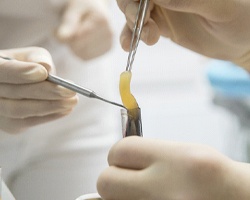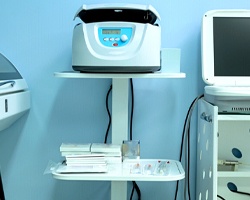Platelet Rich Fibrin – Weyauwega, WI
Encouraging Quicker Healing After Complex Treatment
Patients who undergo tooth extractions, bone grafts, or dental implant placement can expect to spend ample time recovering at home. Unfortunately, the reality of this timely healing process can cause some individuals to avoid treatment and go on to experience more serious dental health problems. Dr. William Twohig offers a safe, natural, and effective solution that not only promotes faster healing but quicker tissue and bone regeneration. With Platelet Rich Fibrin/Platelet Rich Plasma Therapy, we can use your own blood to promote natural healing and faster results. If you would like to schedule a consultation with Dr. Twohig to discuss PRP/PRF Therapy, contact us today.
What is Platelet Rich Fibrin/Platelet Rich Plasma (PRF/PRP)?

PRF is a natural fibrin-based biomaterial prepared without anticoagulants or artificial additives (biomedical modifiers). This allows us to obtain autologous fibrin membranes and plugs with a high concentration of platelets and white cells, releasing growth factors at the surgical site for seven to 14 days and accelerating the natural healing process.
What is the Difference Between PRF and PRP?

Platelet-rich fibrin (PRF) is an autologous platelet concentrate prepared from the patient’s own blood at the dentist’s office just before the dental procedure.
When determining the difference between PRF and PRP, one is a liquid (PRP) and the other is a gel membrane (PRF); however, the real variant is how it is processed. Both PRP and PRF are harvested from an individual’s blood, but one (PRF) proves to be much simpler to process.
PRP requires a more extensive process of mixing blood with anticoagulant and spinning multiple times in a centrifuge to create three layers (i.e. plasma, platelets, and fibrin), which is then placed onto the surgical wound.
PRF Therapy, on the other hand, is more quickly produced by taking a sample of blood and inserting it into a glass tube before placing it in the centrifuge. Requiring no additional modifiers (i.e. anticoagulants, etc.), the blood will begin to separate while spinning, but not entirely. Allowing various cells to remain within the platelet layer, your dentist will collect the sample and directly apply it to the surgical area.
What Are Their Benefits?

When using PRF/PRP during the procedure, you can expect there to be numerous benefits, including:
- Increased healing and a shortened recovery time at home
- Decreased pain and discomfort after your procedure
- Minimal swelling
- Greater strength as the bone and dental implants fuse as well as faster osseointegration time frame
- Greater results after undergoing a bone graft
- Decreased risk for dry sockets after a tooth extraction
How Are They Used in Dentistry?

Platelet-rich fibrin can play an important role in oral and maxillofacial surgery, implant dentistry, periodontal regeneration, and post-extraction site preservation. The fibrin is a reservoir of platelets that will slowly release growth factors and cytokines, which are the key factors for regeneration of the bone and maturation of the soft tissue.
In choosing to use PRF/PRP in dentistry, dental professionals can ensure a safer, more convenient way to help patients heal quicker and more naturally than before. Using an individual’s own blood supply, there is no risk of disease transmission, and the likeliness of infection is significantly decreased.
Platelet Rich Fibrin FAQs

Is Platelet Rich Fibrin Safe?
Platelet-Rich Fibrin (PRF) is considered safe, although it is not FDA-approved. While it lacks official endorsement, the medical dermatology community supports its use. As a byproduct of the patient's blood, PRF poses no risk of disease transmission, which further enhances its safety. Many doctors have observed significant success with PRF, attesting to their effectiveness and safety in medical treatments.
What Should I Avoid Before PRF?
Before PRF treatment, it's strongly recommended that you avoid certain substances. At least three days prior, you should refrain from smoking and drinking. Smoking can delay the healing process, while alcohol consumption can negatively impact blood clotting.
Additionally, certain medications, especially blood thinners, may need adjustment or temporary cessation to prevent complications during the PRF treatment. Be sure to consult with Dr. Twohig to receive specific guidance based on your health and the planned oral surgery.
Who Is Not a Candidate For PRF?
Patients with certain conditions may not be suitable candidates for PRF. Those with blood disorders or on blood-thinning medications may face complications, as these procedures involve drawing and reinjecting blood. Active infections or inflammation in treatment areas can heighten risks.
While safety data for pregnant or breastfeeding individuals is lacking, it's generally recommended to avoid these procedures during this time. Allergy history may pose increased complication risks. Unrealistic expectations may lead to dissatisfaction with results. It's important to discuss individual medical history with a qualified dental professional to determine your candidacy for PRF.
Is PRF Necessary for Tooth Extraction?
Not always! But it can be beneficial in certain cases. It’s commonly used to enhance the healing process and reduce complications after oral surgery. While routine tooth extractions may heal properly without PRF, it becomes particularly valuable in more complex cases, such as wisdom tooth removal or extensive dental procedures. It helps accelerate healing, minimize discomfort, and enhance overall recovery.
Does PRF Prevent Dry Socket?
Yes, PRF has shown promise in reducing the risk of dry socket after tooth extraction. Dry socket occurs when the blood clot that typically forms after extraction is dislodged or dissolves prematurely, leading to pain and delayed healing. PRF, containing concentrated platelets and growth factors, can aid in stabilizing the blood clot, promoting better wound healing, and reducing the chances of dry socket. While not an absolute guarantee, incorporating PRF into the post-extraction care plan has been suggested to enhance clot formation and contribute to a smoother recovery process.
